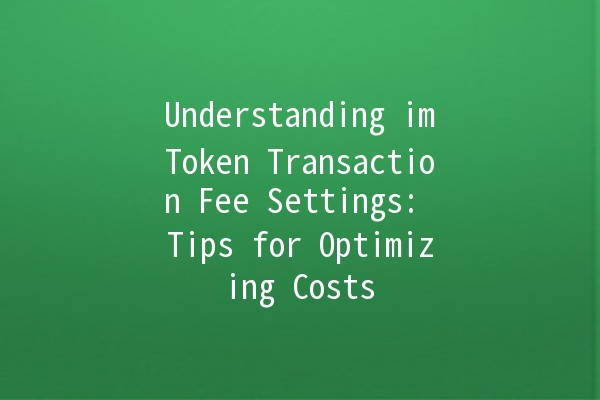imToken is a popular mobile cryptocurrency wallet that supports Ethereum and various ERC20 tokens. Amid the growing interest in cryptocurrencies and decentralized finance (DeFi), users often encounter transaction fees, commonly known as gas fees, when sending or exchanging tokens. Understanding how to manage these fees effectively is essential for users aiming to optimize their transaction costs. This article provides practical tips for navigating imToken's transaction fee settings, enabling users to make informed financial decisions.
Transaction fees are payments made by users to compensate for the computational resources required to process transactions on a blockchain network. These fees can fluctuate based on network demand, transaction complexity, and the urgency of the transaction. In the case of Ethereum, transaction fees are denominated in gas, a unit that measures the amount of computational work required to execute an operation.
To optimize transaction fees on imToken, it’s essential to understand the factors influencing these costs:

To make the most costeffective choices, users should monitor realtime network conditions. Websites like EthGasStation and Etherscan provide current gas prices and congestion levels.
Practical application: Before initiating a transaction, check these platforms to see if gas prices are higher than usual. If possible, postpone your transaction for a period when fees are lower, especially during offpeak hours.
imToken offers advanced settings allowing users to customize their gas price and gas limit. By adjusting these parameters, users can optimize transaction costs based on their needs.
Practical application: If you're not in a hurry, choose a lower gas price. A recommended strategy is to set the gas price slightly below the average to save money while still ensuring reasonable transaction speed.
Users can specify a custom gas limit for their transactions. Setting a limit too high may lead to unnecessary fees if the transaction does not require that much gas. Conversely, setting it too low can cause the transaction to fail.
Practical application: Familiarize yourself with the average gas limits for common transactions. For simple token transfers, a limit of 21,000 gas is typically sufficient. Always adjust this based on the transaction’s complexity.
Understanding the ebb and flow of the Ethereum network can be crucial for costeffective transactions. Executing transactions during times of less congestion can lead to significant savings.
Practical application: Utilize historical data from platforms like Etherscan to identify trends in gas prices. Generally, fees tend to be lower during weekends or latenight hours in your time zone.
Several tools are available for estimating the optimal gas fee for your transaction. For example, imToken provides builtin gas fee estimations, but other platforms can offer additional insights.
Practical application: Before finalizing the transaction, use these estimators to see if you can achieve a better rate. Always remember that the lowest fee may not always guarantee the fastest confirmation, so consider your urgency when making decisions.
Setting a gas price that is significantly lower than the market rate may result in your transaction being delayed or not executed at all. Miners prioritize transactions based on the gas fee offered, so a low fee might lead to the transaction being stuck in the mempool.
Once a transaction is submitted with a specific gas price, you cannot change the gas price. However, you can cancel the transaction if it's still pending and submit a new one with an adjusted gas price.
Network conditions refer to the level of current activity on the Ethereum blockchain. High activity leads to increased competition among users, causing gas prices to rise. Knowing the network conditions can help you decide the best time to execute your transaction to minimize fees.
Unfortunately, gas fees are not refundable once a transaction is submitted. If the transaction fails, you may lose the gas fees associated with that attempt, so it's essential to ensure that the transaction parameters are set correctly before submitting.
Gas fees are influenced by supply and demand in the Ethereum network. During periods of heavy usage, such as popular token sales or sudden spikes in DeFi activity, gas prices can increase significantly. Conversely, during low activity times, prices might drop.
Other wallets and platforms may offer different fee structures and settings. Some users prefer decentralized exchanges or wallets with integrated fee management tools. However, imToken remains popular for its userfriendly interface and reliable performance.
Managing transaction fees on imToken is an essential skill for cryptocurrency users. By understanding the factors that influence fees and implementing practical strategies, users can effectively reduce costs while ensuring timely transactions. Whether through monitoring network conditions, utilizing advanced settings, or learning from transaction trends, users have tools at their disposal to navigate the complexities of imToken’s transaction fee settings. Engaging actively with these tips will empower users to maximize their cryptocurrency experience, minimizing costs and enhancing efficiency in their transactions.